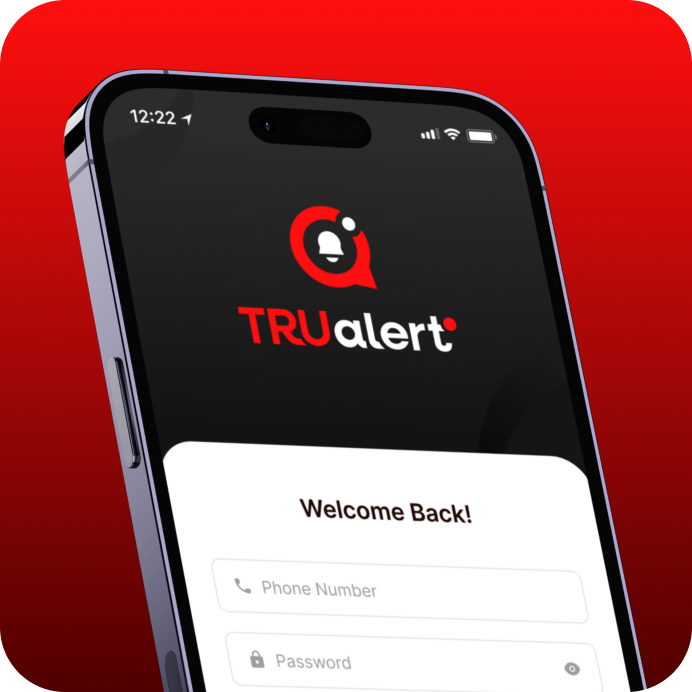TRUalert’s Follow-up Reports offer vital tools for real-time incident tracking, emergency response documentation, and safety improvement—all through SMS-based communication powered by Noonlight. This blog explores how follow-up reports promote transparency, accountability, and a safer campus environment.
What is the purpose of documenting an incident report?
Documenting incident reports is a vital process in ensuring safety, accountability, and continuous improvement in various sectors. These reports provide detailed records that can be reviewed, analyzed, and used for making informed decisions.
Here are the primary purposes of documenting an incident report:
- Ensure Accountability: Incident reports provide a clear, factual record of what happened, who was involved, and how the situation was handled, ensuring that everyone is held accountable for their actions.
- Create a Record for Legal and Insurance Purposes: Incident documentation serves as evidence in case of legal disputes, insurance claims, or workers’ compensation cases, helping establish facts and protecting the involved parties.
- Identify Patterns and Trends: By reviewing incident reports over time, organizations can identify recurring issues or safety concerns that need to be addressed to prevent future occurrences.
- Improve Safety Protocols: Incident reports are essential for evaluating the effectiveness of existing safety measures and protocols. They provide the information needed to revise procedures and improve responses to similar situations in the future.
- Enhance Communication: The documentation process ensures that all parties involved, including emergency responders, management, and security teams, are informed about the incident and any follow-up actions that may be necessary.
- Provide Insight for Training: Detailed reports help with training by offering real-life examples of incidents that can be used to educate staff on how to better handle similar situations in the future.
- Promote Transparency: Documenting incidents openly ensures that all actions are recorded and can be accessed for review, fostering trust between individuals and organizations involved.
- Support Continuous Improvement: Incident documentation helps organizations learn from past events, enhancing their ability to respond to emergencies and improving their overall safety culture.
By thoroughly documenting incidents, businesses and individuals can ensure a higher level of safety and preparedness for future situations.
What is a best practice to follow when documenting incidents?
A best practice when documenting incidents is to ensure that all details are recorded accurately and promptly, including who was involved, what happened, when it occurred, and any actions taken. The report should be clear, concise, and objective, avoiding subjective language or assumptions. Additionally, it is essential to include any relevant evidence such as photographs, witness statements, and time-stamped data to support the incident report’s validity and clarity.
The Importance of Incident Documentation
TRUalert’s Follow-up Reports play a key role in documenting emergency incidents and ensuring detailed records are maintained. This feature helps users and security professionals track the specifics of incidents, including response times, actions taken, and outcomes.
By providing comprehensive documentation, TRUalert fosters accountability and improves safety protocols for future situations. Users can rely on these reports to review and refine emergency procedures, creating a safer environment for individuals with disabilities.
Ensure your safety and accountability in emergencies—download the TRUalert App today and document incidents with ease!
Key Features of TRUalert’s Follow-Up Reports
TRUalert’s Follow-up Reports offer a structured format that includes crucial incident details such as location, time, and the type of emergency. Additionally, it provides information on the actions taken during the event and the response from security professionals.
This documentation is especially valuable for caregivers, security teams, and emergency responders, as it ensures a clear understanding of what occurred during an emergency. The structured nature of these reports enhances accountability and helps with future improvements in emergency response protocols.
Ensuring Accountability in Emergency Situations
One of the primary functions of TRUalert’s Follow-up Reports is to ensure accountability in the handling of emergencies. The detailed records allow users to assess whether the emergency response was timely, efficient, and met the needs of the individual in distress.
Documenting incidents during emergency situations is crucial for ensuring accountability and supporting appropriate follow-up actions. A well-documented incident report provides clear records, facilitating investigations, identifying patterns, and improving safety protocols. Below is a comparison of the benefits of having a documented report versus not having one:
Aspect | With Documented Incident Report | With Documented Incident Report |
|---|---|---|
Accountability | Ensures clear accountability, providing a record of actions taken. | Lack of accountability, making it difficult to track responsibilities. |
Transparency | Increases transparency, helping to clarify the sequence of events. | Hinders transparency, leading to confusion and misunderstandings. |
Investigation & Resolution | Aids in investigations by providing concrete evidence for review. | Leaves room for ambiguity, complicating investigations and resolutions. |
Pattern Recognition | Helps identify recurring safety issues for future improvements. | Misses the opportunity to detect patterns that could prevent future issues. |
Legal Protection | Offers legal protection by showing that the situation was handled appropriately. | Risk of liability due to lack of documented proof of the incident handling. |
This comparison highlights the critical role that documentation plays in ensuring accountability and improving safety management.
By documenting every aspect of the response, TRUalert helps identify areas for improvement and confirms that all steps were taken to ensure the safety of individuals. These reports are especially beneficial for tracking the performance of security personnel and assessing the effectiveness of safety protocols. Take control of your security and keep a detailed record of incidents with TRUalert—download the app now for peace of mind.
Real-Time Incident Tracking and Reporting
TRUalert’s Follow-Up Reports are not just about documenting incidents after they occur; they are part of an integrated real-time incident tracking system. The app’s real-time location tracking and direct communication features ensure that reports are created immediately after an emergency, allowing users and responders to stay on the same page.
This real-time documentation helps keep an accurate timeline of events and provides valuable insight into how quickly and efficiently the situation was handled. The ability to access incident reports instantly after an emergency is crucial for transparency and thoroughness in emergency response.
For any further assistance, here are the top 5 emergency safety hotline numbers in California for real-time incident tracking and reporting:
- California Fire & Rescue Coordination Center (CFRCC)
- Phone: (916) 636-3885
- Provides comprehensive fire and rescue support across California, ensuring fast, efficient coordination during incidents.
- California Department of Public Health (CDPH) Emergency Preparedness
- Phone: (916) 650-6511
- Handles health-related emergencies and provides support for public health threats.
- California Highway Patrol (CHP) Emergency Response
- Phone: (800) 835-5247
- Offers assistance during traffic-related emergencies and incidents on California highways.
- 911 Emergency Services (General)
- Phone: 911
- The primary emergency hotline for all critical incidents, including medical, fire, and police emergencies.
- CA vs. Hate Reporting Hotline
- Phone: (800) 842-5193
- Specifically for reporting hate incidents or crimes, providing immediate support and connecting individuals with appropriate resources.
In times of crisis, these hotlines serve as vital resources for real-time incident tracking and reporting. For more specific incident documentation or reporting needs, these numbers can provide swift, targeted support.
Don’t wait for a crisis to act—download TRUalert now and get real-time tracking and secure follow-up reports at your fingertips.
RELATED CONTENTS:
TRUalert: Your 24/7 Connection to Trained Security Professionals
Real-Time Incident Reporting with TRUalert’s Safety Pulse
TRUalert’s Emergency Response: On-Demand Security at Your Fingertips
How Follow-Up Reports Contribute to Improved Safety
Documented incident reports have proven to be valuable tools for safety and security, contributing significantly to follow-up actions and accountability. Here are a few statistics that highlight their success:
- Incident Reporting Enhances Risk Management: According to a study by SafetyCulture, organizations with structured injury reporting systems saw improved risk management, as these reports allow businesses to identify trends, recognize hazards, and take corrective actions before more serious issues arise. (Resource: Safety Culture)
- Improved Workplace Safety Post-Report: A comprehensive analysis from GuardSignal showed that incidents documented properly with detailed evidence and follow-up reports resulted in a 30% reduction in recurring safety incidents. (Resource: Guard Signal )
- Faster Emergency Response Times: The incorporation of digital tools for documentation has shown to improve emergency response times by up to 25%, as real-time data and follow-ups allow for quicker action by safety teams and responders. (Resource: Guard Signal )
These findings underscore the importance of incident documentation for both immediate response and long-term safety improvements. Regular and thorough documentation not only ensures accountability but also supports proactive safety management.
*For further details, consider exploring resources that discuss workplace injury reporting and best practices in safety culture. (Resource: Safety Culture, Guard Signal )
TRUalert’s Follow-up Reports go beyond simply documenting what happened—they also serve as a tool for continuous improvement. By reviewing these reports, users and organizations can identify patterns and trends in emergency responses, leading to better safety strategies in the future.
For people with disabilities, this feature is particularly important, as it ensures that each emergency is handled with the appropriate response, and any areas needing improvement are addressed. TRUalert helps users learn from every incident, making future emergencies safer and better managed.
Start documenting and tracking incidents today with the TRUalert App
TRUalert’s Follow-up Reports are an invaluable resource for documenting incidents and ensuring accountability in emergency situations. They provide detailed, real-time insights that help improve safety and emergency response, particularly for people with disabilities. For those looking for a comprehensive safety solution, TRUalert’s incident documentation features are essential for better preparedness and peace of mind—download TRUalert today for your safety.




